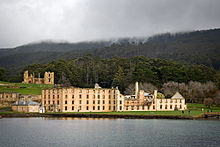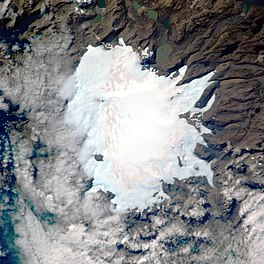Port Arthur, declared a World Heritage Site in 2010
https://en.wikipedia.org/wiki/Tasmania
| UNESCO World Heritage Site | |
|---|---|
 View of Port Arthur, Tasmania, one of the 11 penal sites constituting the Australian Convict Sites | |
| Part of | Australian Convict Sites |
| Criteria | Cultural: iv, vi |
| Reference | 1306-008 |
| Inscription | 2010 (34th Session) |
| Area | 146 ha |
| Buffer zone | 1,216.51 ha |
| Website | portarthur |
| Port Arthur Tasmania | |||||||||
|---|---|---|---|---|---|---|---|---|---|
| Coordinates | 43°09′0″S 147°51′0″E | ||||||||
| Population | 251 (2016 census)[1] | ||||||||
| Established | 1830 | ||||||||
| Postcode(s) | 7182 | ||||||||
| Location |
| ||||||||
| LGA(s) | Tasman Council | ||||||||
| State electorate(s) | Lyons | ||||||||
| Federal division(s) | Lyons | ||||||||
| |||||||||
Port Arthur is a town and former convict settlement on the Tasman Peninsula, in Tasmania, Australia. It is located approximately 97 kilometres (60 mi) southeast of the state capital, Hobart.
The site forms part of the Australian Convict Sites, a World Heritage property consisting of 11 remnant penal sites originally built within the British Empire during the 18th and 19th centuries on fertile Australian coastal strips. Collectively, these sites, including Port Arthur, are described by UNESCO as "... the best surviving examples of large-scale convict transportation and the colonial expansion of European powers through the presence and labour of convicts."[3]
In 1996, the town was the scene of the Port Arthur massacre, the worst instance of mass murder in post-colonial Australian history.
https://en.wikipedia.org/wiki/Port_Arthur,_Tasmania
https://en.wikipedia.org/wiki/List_of_Antarctic_and_subantarctic_islands#List_of_Antarctic_islands_north_of_60%C2%B0_S
Illustration from John Nunn's book about the three years he and his shipwrecked crew survived on the island in the 1820s.
https://en.wikipedia.org/wiki/Kerguelen_Islands
| Cook Ice Cap | |
|---|---|
| Calotte Glaciaire Cook | |
 Aerial view of the ice cap. |
https://en.wikipedia.org/wiki/Cook_Ice_Cap





No comments:
Post a Comment